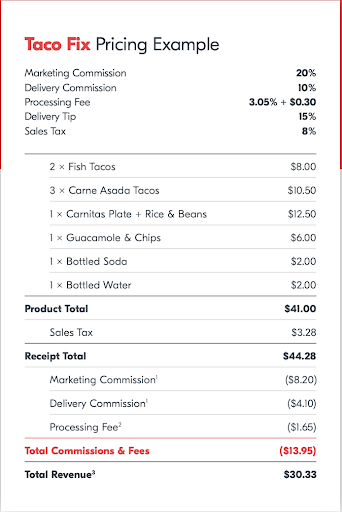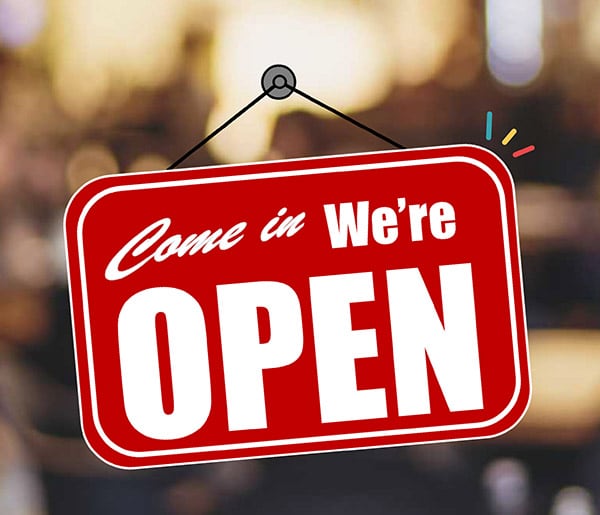
Grubhub fees for restaurants: Comparing third-party delivery options

Giuseppe Badalamenti, owner of Chicago food truck Chicago Pizza Boss, wanted to show guests a big problem with third-party delivery platforms. So he posted a breakdown of his Grubhub order financials to Facebook, where it went viral.
“Stop believing you are supporting your community by ordering from a 3rd party delivery company,” he wrote alongside the financial statement, which showed that for $1,042 in orders, his restaurant received just $376.54 after Grubhub’s fees. “It is almost enough to pay for the food.”
The sad thing is that Badalamenti is far from alone.
It’s no secret that restaurants tend to run on razor-thin profit margins. Since the onset of the coronavirus pandemic last year, third-party delivery apps have been widely criticized for charging fees that can surpass those margins, accelerating the crisis for restaurants that are struggling to stay afloat without in-person dining.
How bad are those fees, really? We looked at a number of popular delivery platforms to compare them. And for restaurants looking for a more budget-friendly alternative—we have that, too.
Grubhub Fees for Restaurants: The True Cost of Third-Party Delivery Apps
According to GrubHub’s website, the financial breakdown that Badalamenti posted on Facebook is likely accurate.
A pricing example shows that Grubhub charges restaurants a number of different fees on every order placed through their platform:
- A 20 percent marketing commission;
- A 10 percent delivery commission;
- A processing fee of just over 3 percent.
Altogether, on a $44 example order, Grubhub takes a total of $13.95 (or just under 32 percent) in commissions and fees.

On Badalamenti’s financial breakdown, we also see that Grubhub deducted $231 from his earnings for “promotions.” It’s not specified what that means, but Eater discovered that around the same time Badalamenti made his post, Grubhub was offering customers $10 off orders of $30 or more. Fine print about the promotion revealed that if restaurants opted in, they would eat those costs, even though they didn’t create or set the promotion themselves.
In December 2020, Grubhub started offering restaurants and eateries another choice: A direct ordering button that they could put on their own website to allow guests to use Grubhub’s technology infrastructure, but not its search platform. For these order, Grubhub charges restaurants delivery, service, and credit card processing fees, but generally no commission fees.
“Even though we may fulfill the order and be the back-end technology, because we’re not providing the marketing service there, we’re not taking a commission,” Chief Revenue Officer Seth Priebatsch said at the time the new feature was announced.
Are Other Third-Party Apps As Bad?
Grubhub is pretty transparent on its website about the fee structure it charges restaurants. Many other third-party delivery services are not as transparent, making it difficult to compare them and see which ones (if any) are better for restaurants. By combing through delivery services’ websites and reading reviews by restaurateurs, we were able to find out that most (if not all) of them also charge high commission rates and fees.
UberEats charges a one-time activation fee to restaurants who want to be listed on the service (though it’s unclear from UberEats’ website how much that fee is). Then, the platform charges a 30 percent commission on delivery orders, and a 15 percent commission on pick-up orders. Some anecdotes from restaurant owners indicate it may be possible to negotiate those rates before signing a contract with UberEats.
Postmates is not transparent online about its fees. But anecdotes from restaurant owners on other sites say the platform charges 15-30 percent in commissions, and also requires restaurants to absorb a direct deposit fee for payments.
Caviar has a base commission rate of 12 percent for pickup orders and 30 percent for delivery orders. According to restaurant customers, though, these rates can vary, and Caviar has offered lower commissions to restaurants as an incentive to join their platform.
Seamless is the only major delivery platform to use a “pay-to-play model,” meaning restaurants that choose higher commission rates will get better positions in restaurant search results on their app and website.
DoorDash charges up to 30 percent commission on every order.
Chownow uses a subscription service model, offering online orders and delivery to restaurants for a flat monthly fee.
Amid the pandemic, third-party delivery platforms have been heavily criticized for not doing more to help restaurants in crisis. In response, some of them have deferred or lowered fees. In addition, some cities have passed ordinances capping the commissions and fees delivery apps can charge restaurants. In many of those cases, the apps are simply shifting the costs to customers, instead.

And amid growing competition in the food delivery app space, some restaurants—especially large chains—have negotiated lower commissions and fees by agreeing to list their business on just on platform.
Other Cons to Using Third-Party Delivery Apps
Pricing might be the biggest downside to using third-party delivery apps, but there are others, as well.
For one, using a third-party platform severely limits the control restaurants have over the entire process. They’re limited in how they can brand and present their restaurant within the app. They also have less control over the delivery process; for example, they can’t control the quality and care of a delivery driver.
And then there’s all the data they’re giving away. When guests place online orders directly from your restaurant’s website or call for takeout or delivery, you can collect valuable data from them—their contact information, how much they typically spend, their favorite dishes, the time of day they like to order food, and more. This data can be used to remarket to guests later, enticing them to make repeat visits to your restaurant. But when restaurants use third-party delivery platforms, they don’t get any of that data—the apps do.
Popmenu: The All-in-One Digital Platform That Offers Delivery and More
There must be a better choice for independent and local restaurants, right? There is. It’s Popmenu.
Popmenu makes it both easy and affordable for restaurant partners to offer online orders and delivery. There are no commissions, and you can use your own in-house delivery drivers or take advantage of our partnership with DoorDash that helps save on their fees.
But here’s what’s so great about Popmenu: It offers so much more than just delivery.

Popmenu is the all-in-one digital toolkit for modern restaurants. From website design and management, online ordering, contactless ordering, and automated remarketing, to dynamic menu design, Popmenu can bring your restaurant all the way into the digital age with just one affordable platform.
Ready to Ditch Delivery Fees and Commissions? Get Popmenu
You can get all of the tools Popmenu offers for just one flat monthly fee. And here’s the best part: That fee never goes up. We guarantee it.
There are no set-up fees. No commissions. No percentages. No hidden charges. Just a fair, flat fee that allows independent restaurants like yours to own delivery and get the tools they need — all while protecting their bottom line.
Ready to see how Popmenu can help your restaurant? Schedule a demo today.





.jpeg)






